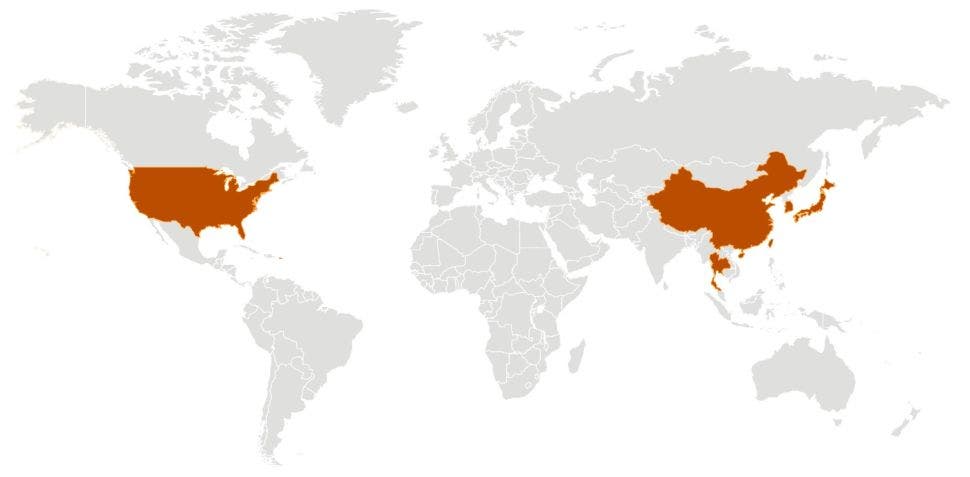The outbreak of new coronavirus pneumonia has the potential to affect hundreds of millions of people. To this end, the US Center for Disease Control and Prevention (CDC) temporary guidance for the prevention and control of new coronavirus (Chinese version). The center’s work focuses on the development and application of disease prevention and control. This includes environmental health, occupational health, health promotion, prevention and education activities.

US CDC New Coronavirus Prevention Guide – Full Text
This interim guide is based on currently known information on the spread of respiratory infections with the new coronavirus 2019 (2019-nCoV) and other viruses. The Centers for Disease Control and Prevention (CDC) will update this interim guide as needed and as more information becomes available.
Coronaviruses are a large group of viruses, some of which cause disease in humans, while others spread between animals, including camels, cats, and bats. In rare cases, animal coronaviruses can evolve and infect humans and then spread among humans, as seen in the Middle East Respiratory Syndrome (MERS) and Severe Acute Respiratory Syndrome (SARS). The possibility of person-to-person transmission of 2019-nCoV is unclear. The following temporary guidelines may help prevent the virus from spreading in families and communities.

This interim guide applies to the following situations:
- Patient has been diagnosed with 2019-nCoV infection but does not require hospitalization and can be treated at home
- Patient is undergoing 2019-nCoV infection assessment by medical staff who does not require hospitalization and can be treated at home
- Caregivers and family members of patients who have been diagnosed with or are being assessed for 2019-nCoV infection
- Others who have close contact with a patient who has been diagnosed with a 2019-nCoV infection or is being assessed for a 2019-nCoV infection
Preventive measures for patients who have been diagnosed with 2019-nCoV infection or are being assessed for 2019-nCoV infection at home
Your doctor and public health staff will assess whether your case can be treated at home. If it is determined that you can be isolated at home, you will be monitored by staff at your local or state health department. You should follow these precautions until your health care provider or local or state health department tells you that you can resume normal activities.

Except for medical treatment, stay at home
In addition to providing medical care, you should restrict your travels. Do not go to work, school or public places, and do not use public transport or taxis.
Isolate yourself from others in your home
You should stay in a different room from the rest of the family as possible. In addition, you should use a separate toilet, if available.
Call your doctor before going to the clinic
Before you make an appointment, call the medical staff and tell them that you have a 2019-nCoV infection or are undergoing a 2019-nCoV infection assessment. This will help the medical staff’s clinics take steps to prevent others from getting infected.
Wear mask
You should wear a mask when you are in the same room as other people, and when you visit a medical staff. If you can’t wear a mask, someone who lives with you should wear a mask when you are in the same room as you.
Covers coughs and sneezes
Cover your mouth and nose with a tissue when you cough or sneeze, or cover with your sleeve when you cough or sneeze. Throw used paper towels in a plastic bag trash can, and immediately wash your hands with soap and water for at least 20 seconds.
Wash hands
Wash your hands thoroughly with soap and water frequently for at least 20 seconds. If soap and water are not available and your hands are not significantly dirty, you can use an alcohol-based hand sanitizer. Avoid touching your eyes, nose, and mouth with your unwashed hands.
Avoid sharing household items
You should not share dishes, drinking glasses, cups, cutlery, towels, bedding or other items with other people in your household. After using these items, wash them thoroughly with soap and water.
Monitor your symptoms
If your condition worsens (such as difficulty breathing), seek medical attention immediately. Before you make an appointment, call the medical staff and tell them that you have a 2019-nCoV infection or are undergoing a 2019-nCoV infection assessment. This will help the medical staff’s clinics take steps to prevent others from getting infected. Ask your medical staff to call your local or state health department.
Gizchina News of the week
Preventive measures for caregivers and family members
If you live with or care for a patient who has been diagnosed with a 2019-nCoV infection or is undergoing a 2019-nCoV infection assessment, you should:
Make sure you understand and can help patients – follow the medical staff’s medication and treatment instructions. You should help patients get basic home needs and support them in buying groceries, prescription drugs, and other personal needs.
- Leave someone at home who provides the necessary care for the patient.
- Other family members should stay in other residences or places of residence. If this is not possible, they should stay in another room or be as isolated from the patient as possible. If possible, use a separate toilet.
- Restrict unnecessary guests from coming home.
- Avoid access to patients by the elderly and people with compromised immune systems or chronic health conditions. These people include patients with chronic heart disease, lung or kidney disease, and diabetes.
- Make sure the common spaces in your home are well ventilated, such as using air conditioners or opening windows if weather permits.
- Wear disposable masks, protective clothing, and gloves when touching the patient’s blood, body fluids and/or secretions (such as sweat, saliva, sputum, nasal mucus, vomit, urine or diarrhea).
- Dispose of disposable masks, protective clothing, and gloves after use. Do not reuse.
- Wash hands immediately after removing masks, protective clothing and gloves.
- Avoid sharing household items. You should not share dishes, drinking cups, cups, cutlery, towels, bedding or other items with patients who have been diagnosed with a 2019-nCoV infection or are being assessed for a 2019-nCoV infection. After the patient has used these items, they should be thoroughly washed (see “Cleaning Your Clothes Thoroughly” below).
- Clean all “high-frequency contact” surfaces, such as counters, tabletops, door handles, toilet fixtures, toilets, mobile phones, keyboards, tablets and bedside tables, daily. In addition, clean any surfaces that may carry blood, body fluids and / or secretions or excreta.
- Read the label of the cleaning product and follow the recommendations provided on the product label. The label contains instructions for the safe and effective use of cleaning products, including precautions you should take when using the product, such as wearing gloves or an apron and ensuring good ventilation during the use of the product.
- Use diluted bleach or a household disinfectant labeled “EPA-approved.” When preparing bleach at home, add 1 tablespoon of bleach to 1 quart (4 cups) of water. For more bleach, add ¼ cup of bleach to 1 gallon (16 cups) of water.
- Wash clothing thoroughly.
- For clothing with blood, body fluids and/or secretions or feces, remove and wash immediately
- Wear disposable gloves when handling contaminated items. Wash hands immediately after removing gloves.
- Read and follow the instructions on the laundry or laundry labels and detergent labels. Generally, the highest temperature recommended on the laundry label is used to wash and dry the laundry.
- Put all used disposable gloves, protective clothing, masks, and other contaminated items in containers with plastic bags before putting them in other household waste. Wash your hands immediately after handling these items.
- Monitor patients for symptoms. If the patient’s condition is more serious, call their medical staff and tell them that the patient has a 2019-nCoV infection or is undergoing a 2019-nCoV infection assessment. This will help the medical staff’s clinics take steps to prevent others from getting infected. Ask the medical staff to call your local or state health department.
- Caregivers and family members who are in close contact with a patient who has been diagnosed with 2019-nCoV infection or are being assessed for 2019-nCoV infection are considered “close contacts” if they fail to observe precautionary measures and should monitor their health. Follow the precautions below for close contacts.
- Discuss any other issues with your state or local health department
Preventive measures for close contacts
If you have close contact with a patient who has been diagnosed with a 2019-nCoV infection or is being assessed for a 2019-nCoV infection, you should:
- Monitor your health from the day you first come into close contact with the patient and continue to monitor your health for 14 days after your last close contact with the patient. Observe these signs and symptoms:
- Fever. Measure your temperature twice a day.
- Cough.
- Shortness of breath or difficulty breathing.
- Other early symptoms that require attention include chills, physical pain, sore throat, headache, diarrhea, nausea/vomiting, and runny nose.
- If you have a fever or any of these symptoms, call your medical staff immediately.
- Before you make an appointment, be sure to tell your medical staff that you have close contact with a patient who has been diagnosed with a 2019-nCoV infection or is undergoing a 2019-nCoV infection assessment. This will help the medical staff’s clinics take steps to prevent others from getting infected. Ask your medical staff to call your local or state health department.
If you don’t have any symptoms, you can continue with your daily activities, such as going to work, school, or other public places.



